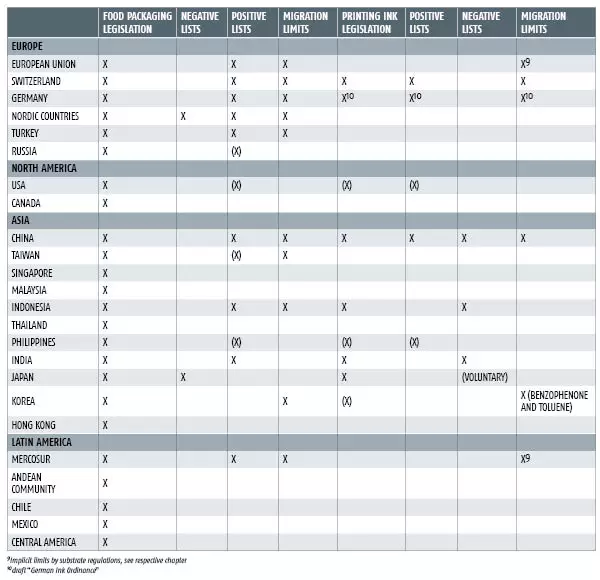Ink migration in food packaging and regulations
The awareness of ink migration in food packaging is growing; let's look at different mechanisms of ink migration and an overview of the different type of regulations across various countries.
31 Mar 2017 | By WhatPackaging? Team
Migrants are substances which, due to their chemical characteristics and molecular size, move from a printed layer into the packed food. Polymeric materials are generally large molecules without migration potential, thus they are usually not regarded as migrants. In addition, if ever ingested, polymeric substances with molecular weights above 1000 Daltons are not absorbed by the gastro-intestinal tract and thus are not considered by the European Food Safety Authority (EFSA) to present a toxicological risk.
Inorganic materials (such as white titanium dioxide pigment, calcium carbonate fillers, silica matting agents) are crystalline particles and therefore not migrants. Unlike the soluble dyes (basic dyes, acid dyes) which were sometimes used as colorants in the past, today’s organic pigments commonly used as colorants in inks are generally not regarded as being migrants, either.
There are different types of migration:
Set-off migration
Migrants can migrate from one layer to another, such as a surface printed layer to the non-printed food-contact surface which is later on brought into contact with food. If these are in direct or close contact like in a reel or a stack after printing, set-off migration can occur due to the pressure existing in the reel or stack.

Diffusion migration
Small and mobile molecules can easily penetrate into and diffuse across packaging material layers. This can occur even if the printed material has not yet been converted into a food package and filled with food, or later on when the printed package is filled with food and the food starts to ‘extract’ the migrants from the packaging material.

The following upper figure illustrates set-off migration in a reel or stack, demonstrating that migration can occur even if an aluminum foil (indicated as ‘barrier’) prevents diffusion migration across the packaging material layers. It also shows that set-off migration can take place even if the ink layer as such is not in direct contact with the inner (food contact) PE layer, but another PE layer lies in between. The lower figure illustrates a situation where both diffusion migration and setoff migration take place. The situations shown are situations for liquid food cartons and demonstrate the cause and effect of the ‘ITX case'.

Gas-phase migration
Migrants can also migrate from a cardboard (the ‘releasing reservoir’) via the gas phase within the pack, to end up in food which acts as ‘recipient reservoir’ (gas phase migration). This can, for example, occur with migrants such as mineral oils or some UV photoinitiators that might not be generally known as being volatile such as organic solvents.

High-temperature applications
High-temperature treatments enhance the release of migrants from the printed layers. Typical cases are boiling the food in the bag, pasteurisation, autoclave sterilisation of packed foods under increased pressure, or food in microwaveable and ovenable packaging. Furthermore, high temperature increases the mobility of migrants in the material layers through which they diffuse. Hot water and hot water vapour will add to this effect, because migrants are strongly driven out of a printed layer and, if not hindered by barriers, may be quickly carried into food by streams caused by steam distillation and condensation.
Additionally, the possibility should be considered that, in particular if high-temperature exposure is involved, all food contact materials, including printed layers, may form small but potentially relevant quantities of breakdown products. These may consist of new low molecular substances, which were not present in the ink itself.
Drying process
Equivalently, in printed layers obtained via oxidative or UV curing, breakdown products, i.e. as formed from photoinitiators during the photo-induced hardening process, might be present.
For printed layers from UV and electron beam curing (EB) inks, attention is also to be paid to minimise residual oligomers or monomers from incomplete polymerisation. Finally, if the drying process is not sufficiently driven to be complete, in printed layers from solvent-based and water-based inks, relevant amounts of residual solvents or retarders might be present as potential migrants.
Migrants usually disperse based on physical-chemical rules, depending not only on temperature but also on time. This means that, if the contact materials allow transfer of substances and if the contact time is long enough, migrants from thin ink layers might disperse completely and will for the most part end up in the packed foodstuff.
Jatin Takkar,
Deputy manager – product safety and regulatory, Siegwerk
Legal requirements and responsibilities
Food packaging is primarily intended for the protection of food. It is printed for product presentation and advertising as well as to provide information to the final consumer in accordance with, e.g. in Europe, the Regulation (EU) No 1169/2011 relating to the labeling (concerning contents food ingredients and nutrition facts). In addition, printing is carried out for decorative and protective reasons.
There are exceptional instances where printing inks are applied on the inner side of the packaging or on inserts, for example, for promotional purposes, and intentionally have direct food contact. These cases are only negligible in volume, and therefore this chapter mainly deals with printing inks applied to the non-food surface of food packaging.
The definition of packaging inks also includes primers, lacquers and overprint varnishes applied by a printing and/or coating process, such as flexography, gravure, letterpress, offset, screen, non-impact printing or roller coating.
The following table gives, as a summary, an overview on the type of regulations in the different countries.

This is the first of the four-part article series on printing inks for food packaging by Siegwerk.











 See All
See All